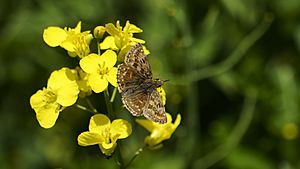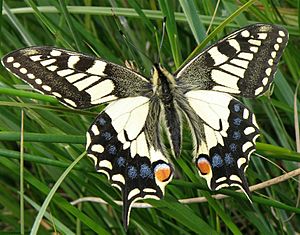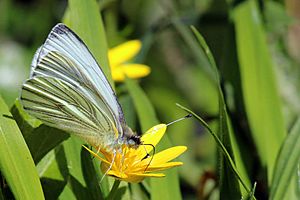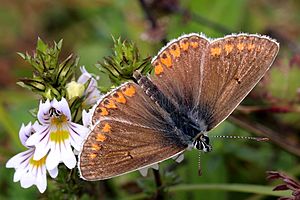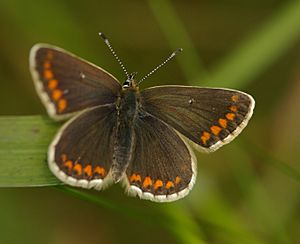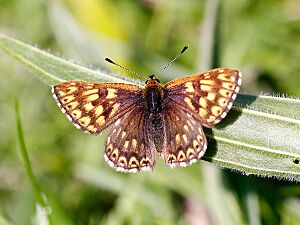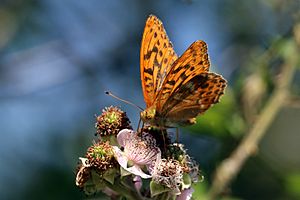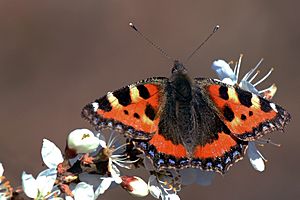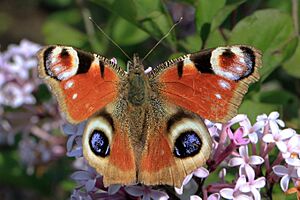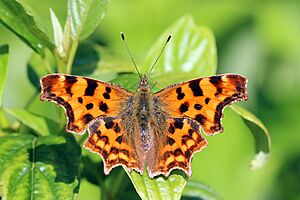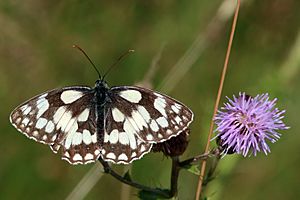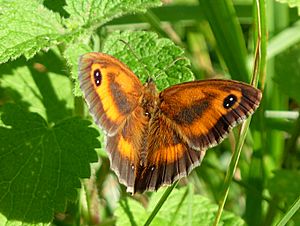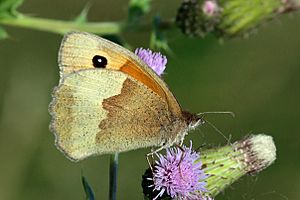List of butterflies of Great Britain facts for kids
This article is about the different kinds of butterflies you can find in Great Britain. It includes butterflies that live here all the time, those that visit from other countries, and some that are sadly no longer found here.
A study in 2004 found that the number of many butterfly species dropped by 71% between 1983 and 2003. Because of this, many butterflies are now on a special list called the Red List. This list helps people know which butterflies need our help the most. For example, some are "regionally extinct" (RE), meaning they are gone from Great Britain. Others are "critically endangered" (in great danger), "endangered" (E), "vulnerable" (V), or "near threatened" (NT). The good news is that 29 species are listed as "least concern" (LC), meaning they are not currently in danger.
Butterfly Conservation, a group that helps butterflies, says that 29 of Great Britain's 58 types of breeding butterflies are a "High UK threat priority." This means they need urgent help to survive.
Contents
Hesperiidae – Skippers
Skippers are small to medium-sized butterflies. They have a fast, darting flight, which is how they got their name!
Subfamily Heteropterinae
- Chequered skipper – Carterocephalus palaemon LC
-
- This butterfly used to be found in southern and eastern England. Now, it mainly lives in western Scotland. There's a project trying to bring it back to Rockingham Forest, England.
Subfamily Hesperiinae
- Small skipper – Thymelicus sylvestris LC
- Essex skipper – Thymelicus lineola LC
-
- This butterfly lives mostly in south-east England. You can also find smaller groups in the West Country and as far north as the Humber river. It is also spreading north and west.
- Lulworth skipper – Thymelicus acteon NT
- Silver-spotted skipper – Hesperia comma V
- Large skipper – Ochlodes sylvanus LC
-
- You can find this skipper all over England and Wales, reaching north into south-west Scotland.
Subfamily Pyrginae
- Dingy skipper – Erynnis tages tages LC
-
- This butterfly is found in many parts of England and Wales, and also in the Scottish Highlands.
- Grizzled skipper – Pyrgus malvae V
-
- This skipper lives in southern England, reaching north to north-east Wales and south-east Wales.
Papilionidae – Swallowtails
Swallowtails are known for their large size and often have "tails" on their hindwings.
Subfamily Papilioninae
- Swallowtail – Papilio machaon V
-
- The P. machaon britannicus type of swallowtail is special to Great Britain and only lives in the Norfolk Broads. It used to live in The Fens too.
- Another type, P. machaon gorganus, is a rare visitor from Continental Europe and sometimes breeds in southern England and southern Wales.
Pieridae – Whites and Yellows
This family includes many common butterflies, often white or yellow in color.
Subfamily Dismorphiinae
- Wood white – Leptidea sinapis sinapis E
-
- This butterfly is found in specific areas like Devon and west Somerset, Surrey, Buckinghamshire and Northamptonshire, and Worcestershire and Herefordshire.
Subfamily Coliadinae
- Dark clouded yellow – Colias croceus LC
-
- This butterfly is a visitor from other countries, but it can sometimes survive the winter in the south-west. In some years, it can be seen as far north as the River Clyde.
- Common brimstone – Gonepteryx rhamni rhamni LC
-
- You can find this butterfly all over England (except the far north) and Wales (except the south-west, central west, and far north-west). It is spreading its range north.
Subfamily Pierinae
- Large white – Pieris brassicae LC
-
- This butterfly is found everywhere, but it is less common in the north-west of Scotland.
- Small white – Pieris (Artogeia) rapae LC
-
- You can find this butterfly everywhere except the very far north.
- Green-veined white – Pieris (Artogeia) napi LC
-
- The P. napi sabellicae type is found almost everywhere. The P. napi thomsoni type lives in east-central Scotland.
- Orange tip – Anthocharis cardamines britannica LC
-
- This butterfly is found everywhere except the far north and north-west. It is spreading in Scotland and becoming more common in England and Wales.
Lycaenidae – Hairstreaks, Coppers, and Blues
This family includes many small, often brightly colored butterflies.
Subfamily Theclinae
- Green hairstreak – Callophrys rubi LC
-
- This butterfly is found in many parts of the country.
- Brown hairstreak – Thecla betulae V
- Purple hairstreak – Neozephyrus (Quercusia) quercus LC
-
- Found throughout most of England and Wales, and less commonly north to the River Clyde.
- White-letter hairstreak – Satyrium (Strymonidia) w-album V
-
- Found in much of England (except the far south-west and north-west) and eastern Wales.
- Black hairstreak – Satyrium (Strymonidia) pruni E
-
- This butterfly is only found on heavy clay soils along the Chiltern hills.
Subfamily Lycaena
- Small copper – Lycaena phlaeas eleus LC
-
- Found everywhere except the far north and north-west.
Subfamily Polyommatinae
- Small blue – Cupido minimus NT
-
- Found in southern and south-central England, the south Wales coast, and the east coast of Scotland, but not everywhere in these areas.
- Silver-studded blue – Plebejus argus V
-
- There are different types of this butterfly. P. argus argus is in south-west and south England, the East Anglia coast, and north Wales. P. argus cretaceus used to be on chalk and limestone downland but is now only found at Portland Bill. P. argus caernensis lives at Great Ormes Head in north Wales. The P. argus masseyi type is extinct.
- Brown argus – Aricia agestis LC
-
- Found throughout southern England, north to the River Tees, and on the south and north coasts of Wales. It is spreading its range north.
- Northern brown argus – Aricia artaxerxes V
-
- The A. artaxerxes salmacis type is found in England from north Lancashire northwards. The A. artaxerxes artaxerxes type lives in Scotland.
- Common blue – Polyommatus icarus icarus LC
-
- Found everywhere.
- Chalkhill blue – Lysandra coridon V
-
- Found in southern England.
- Adonis blue – Lysandra bellargus V
-
- Found in southern England and is spreading north and west.
- Holly blue – Celastrina argiolus britanna LC
-
- Found north to the Solway Firth and River Tyne and is spreading its range north.
- Large blue – Phengaris arion NT
-
- The P. arion eutyphron type, which was special to Great Britain, is now extinct. The P. arion arion type has been brought back to various places in west England.
Riodinidae – Metalmarks
This small family has only one species in Great Britain.
- Duke of Burgundy – Hamearis lucina V
-
- Found in central-south England, with smaller groups in north-east, north-west, and south-east England.
Nymphalidae – Fritillaries, Nymphalids, and Browns
This is a large and diverse family, including many well-known butterflies.
Subfamily Heliconiinae
- Small pearl-bordered fritillary – Boloria (Clossiana) selene V
-
- The B. selene selene type is found widely in Wales, Scotland, and southern and northern England. The B. selene insularum type lives in western Scotland and the Inner Hebrides.
- Pearl-bordered fritillary – Boloria (Clossiana) euphrosyne V
-
- Found in scattered areas throughout southern England, Wales, north-west and north-east England, and Scotland.
- High brown fritillary – Fabriciana adippe E
-
- Found in scattered areas in west England and Wales.
- Dark green fritillary – Speyeria aglaja NT
-
- The S. aglaja aglaja type is found in scattered areas everywhere except Scotland. The S. aglaja scotica type lives in Scotland.
- Silver-washed fritillary – Argynnis paphia LC
-
- Found in the south-western half of England and Wales. It is spreading its range east, including to East Anglia.
Subfamily Limenitidinae
- White admiral – Limenitis camilla V
-
- Found in southern England and eastern Wales.
Subfamily Apaturinae
- Purple emperor – Apatura iris LC
-
- Found in southern England.
Subfamily Nymphalinae
- Red admiral – Vanessa atalanta LC
-
- This butterfly lives here and is also a common visitor from other countries. It is found everywhere.
- Painted lady – Vanessa carduiLC
-
- This butterfly is a visitor from other countries and is found everywhere.
- Small tortoiseshell – Aglais urticae LC
-
- Found everywhere.
- Peacock – Aglais ioLC
-
- Found everywhere except the Scottish Highlands and Western Isles. It is spreading its range throughout Scotland, including the Western Isles.
- Comma – Polygonia c-album LC
-
- Found throughout England and Wales. It is spreading north and becoming more common in southern Scotland.
- Marsh fritillary – Euphydryas (Eurodryas) aurinia V
-
- Found in scattered areas, mostly in the west.
- Glanville fritillary – Melitaea cinxia E
-
- Found on the southern coast of the Isle of Wight and the Channel Islands. It used to be found widely in the south-east.
- Heath fritillary – Melitaea athalia E
-
- Found in the West Country and Kent. It has been brought back to Essex.
Subfamily Satyrinae
- Speckled wood – Pararge aegeria LC
-
- The P. aegeria tircis type is found throughout the southern third of Great Britain and the Scottish Highlands. It is spreading north and east in England and Scotland and has even moved to the Isle of Man. The P. aegeria oblita type lives in western Scotland and the Inner Hebrides. The P. aegeria insula type is found in the Isles of Scilly.
- Wall – Lasiommata megera E
-
- Found throughout England and Wales, and in southern Scotland (in specific places). It is spreading north, but has quickly disappeared from inland areas in East Anglia.
- Small mountain ringlet – Erebia epiphron NT
-
- The E. epiphron mnemon type is found in Cumbria. The E. epiphron scotica type lives in central Scotland.
- Scotch argus – Erebia aethiops V
-
- The E. aethiops aethiops type is found in Cumbria. The E. aethiops caledonia type lives in Scotland.
- Marbled white – Melanargia galathea serena LC
-
- Found throughout the south-east half of the country, including the West Country, but not most of East Anglia. It is spreading north.
- Grayling – Hipparchia semele E
-
- There are different types of this butterfly. H. semele semele is found on much of the English coast and inland in parts of the south and East Anglia. H. semele scota is in eastern Scotland (near the coast). H. semele thyone lives in Wales. H. semele atlantica is found in the Hebrides.
- Gatekeeper – Pyronia tithonus britanniae LC
-
- Found throughout the southern half of the country, except central Wales. It is spreading north.
- Meadow brown – Maniola jurtina LC
-
- The M. jurtina insularis type is found almost everywhere. The M. jurtina cassiteridum type lives in the Isles of Scilly. The M. jurtina splendida type is in western Scotland, including the Hebrides.
- Ringlet – Aphantopus hyperantus LC
-
- Found everywhere except north-west England and the north-west half of Scotland. It is spreading in the English Midlands, western England, the English–Scottish borders, and Scotland.
- Small heath – Coenonympha pamphilus V
-
- The C. pamphilus pamphilus type is found everywhere except the far north and Hebrides. The C. pamphilus rhoumensis type lives in the Hebrides.
- Large heath – Coenonympha tullia E
-
- The C. tullia davus type is found in scattered areas throughout northern and central England. The C. tullia polydama type is in central-west and north Wales, northern England, and southern Scotland. The C. tullia scotica type lives in the rest of Scotland.
Rare Visitors and Lost Species
Some butterflies used to live in Great Britain but are now gone, or they only visit rarely from other countries.
Extinct Species
These butterflies are no longer found in Great Britain:
- Black-veined white – Aporia crataegi RE
- Mazarine blue – Cyaniris semiargus RE
- Large copper – Lycaena dispar RE
- Large tortoiseshell – Nymphalis polychloros RE (though some sightings suggest it might be returning)
Vagrant Species
These butterflies are rare visitors to Great Britain, usually blown over from mainland Europe:
- Pale clouded yellow – Colias hyale
- Long-tailed blue – Lampides boeticus
- Scarce swallowtail – Iphiclides podalirius
- Camberwell beauty – Nymphalis antiopa
- Monarch – Danaus plexippus
Images for kids
See also
- Butterfly Conservation – A group that helps protect butterflies and moths in Britain.
- List of butterflies of Ireland
- List of moths of Great Britain


